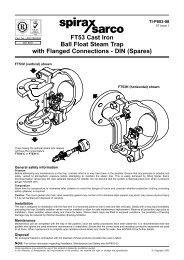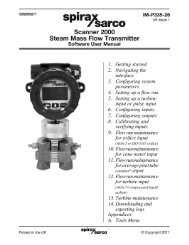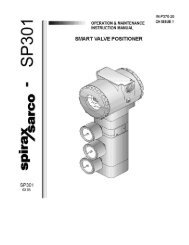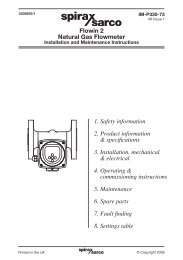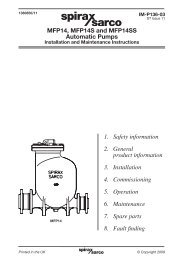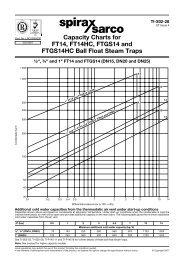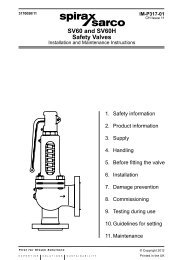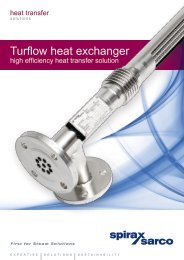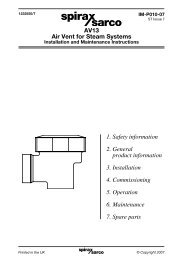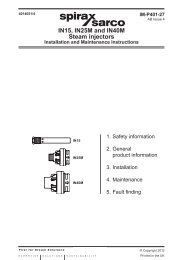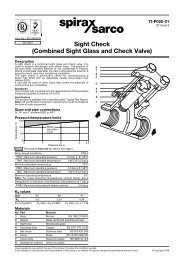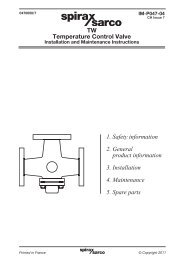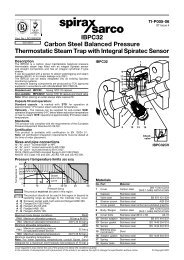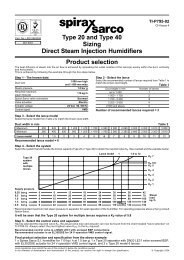Scanner 2000 Steam Mass Flow Transmitter ... - Spirax Sarco
Scanner 2000 Steam Mass Flow Transmitter ... - Spirax Sarco
Scanner 2000 Steam Mass Flow Transmitter ... - Spirax Sarco
You also want an ePaper? Increase the reach of your titles
YUMPU automatically turns print PDFs into web optimized ePapers that Google loves.
<strong>Scanner</strong> ® <strong>2000</strong> microEFM Section 2<br />
RTD Assembly Options (for Gas and Liquid <strong>Flow</strong> Runs Only)<br />
The RTD is installed in a thermowell downstream of the primary differential pressure source. The location of<br />
the thermowell should conform to the relative standard to ensure accurate measurement.<br />
CAUTION The RTD must be fitted to a suitably certified and dimensioned enclosure or fitted to an<br />
enclosure in a non-hazardous area.<br />
Cameron recommends the use of the Barton Model 21 RTD, a 4-wire, 100-ohm explosion-proof RTD<br />
assembly that can be connected to the <strong>Scanner</strong> <strong>2000</strong> enclosure without conduit or a conduit seal. For details,<br />
see Explosion-Proof RTD Assembly, page A-3.<br />
A 2-wire, 3-wire, or 4-wire RTD assembly may be used to provide a process temperature input.<br />
Mounting Options<br />
The <strong>Scanner</strong> <strong>2000</strong> microEFM can be mounted using the following methods:<br />
• Direct-mount to an orifice or cone type DP meter. The integral multi-variable sensor may be connected to<br />
the pressure taps with stabilizers or a heavy wall nipple with adapter flanges, and a 5-valve manifold. A<br />
bottom-port MVT is recommended for gas measurement; a side-mount MVT is recommended for liquid<br />
or steam measurement.<br />
• Direct-mount to a turbine meter. The CSA-certified instrument can be mounted to a turbine meter using a<br />
pipe adapter and union connection (Figure 2.2, page 28). The ATEX-certified instrument can be mounted to<br />
a Barton 7000 Series meter using a turbine meter pickup extension (Figure 2.3, page 29).<br />
• Pole-mount. The instrument can be mounted on a 2-in. pole using a NuFlo hardware kit, or bulkheadmounted<br />
to a flat, vertical surface (Figure 2.4, page 29). Pole mounting may be preferred where limited<br />
space or pipe vibration prohibits direct-mount installation. A horizontal pipe mount is recommended for<br />
liquid and steam installations using a side-port MVT and block manifold. Tubing is used to connect the<br />
integral MVT to the orifice meter or cone meter. If a <strong>Scanner</strong> <strong>2000</strong> will be used for steam measurement, a<br />
condensate pot must also be installed to protect the <strong>Scanner</strong> <strong>2000</strong> from extreme temperatures. See Measuring<br />
<strong>Steam</strong> via a Differential Pressure Meter, page 39, for details.<br />
The following accessories are also recommended:<br />
• a 5-valve manifold for connecting process lines to the integral MVT<br />
• an RTD assembly (see Explosion-Proof RTD Assembly, page A-3) for process temperature input on gas flow<br />
runs and compensated liquid flow runs (not recommended for steam flow runs)<br />
• tubing and/or pipe for plumbing process connections<br />
• explosion-proof signal cable for remote turbine connections (stranded, shielded cable is recommended)<br />
Pole-Mount Installation<br />
To mount the <strong>Scanner</strong> <strong>2000</strong> using the optional pole-mount kit, perform the following steps:<br />
1. Determine the pipe orientation (horizontal or vertical) that will best accommodate process connections<br />
and field wiring connections. A horizontal pipe mount is recommended for liquid and steam installations<br />
using a side-port MVT and block manifold.<br />
2. Connect the mounting bracket to the <strong>Scanner</strong> <strong>2000</strong> using the two bolts provided (Figure 2.4, page 29).<br />
3. Position the U-bolt around the pipe and through the support bracket provided with the U-bolt.<br />
27



